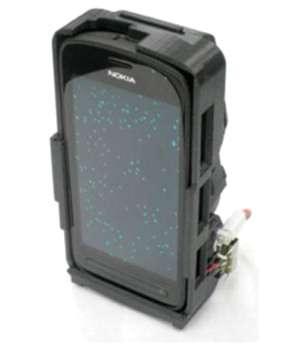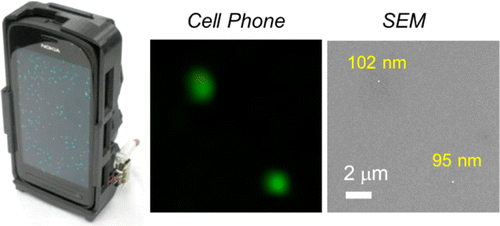Improved smartphone microscope brings single-virus detection to remote locations

Scientists are reporting an advance in smartphone-based imaging that could help physicians in far-flung and resource-limited locations monitor how well treatments for infections are working by detecting, for the first time, individual viruses. Their study on the light-weight device, which converts the phone into a powerful mini-microscope, appears in the journal ACS Nano.
Aydogan Ozcan and colleagues note that conventional imaging techniques for detecting disease-causing bacteria and viruses rely on expensive microscopes with multiple lenses and other bulky optical components. In places with limited resources, doctors have few options for determining how well a treatment is working. To address the need for more portable and less expensive medical equipment, researchers, including Ozcan's group at the University of California, Los Angeles, recently have developed various compact microscopes that can be fitted onto smartphones to detect microbes or to check patients' eyesight. The team set out to build on these advances and produce a more refined imaging device that works on the nanoscale to count the number of sub-micron bacteria or viruses in a sample.
The result is a portable imaging system that harnesses the digital power of today's smartphones to detect individual viruses and determine viral load—the severity of infection—which can indicate the effectiveness of a treatment. It only weighs six-and-a-half ounces, or little more than a baseball. Using their new smartphone microscope, the scientists detected individual, fluorescently labeled human cytomegalovirus, a member of the herpes virus family that can be life-threatening in patients with low immunity. It's also one of the leading causes of virus-associated birth defects. The scientists conclude that the microscope "holds significant promise for various point-of-care applications such as viral load measurements or other biomedical tests conducted in remote or resource-limited environments."

The article is titled "Fluorescent Imaging of Single Nanoparticles and Viruses on a Smart Phone."
More information: Fluorescent Imaging of Single Nanoparticles and Viruses on a Smart Phone, ACS Nano, Article ASAP. DOI: 10.1021/nn4037706
Abstract
Optical imaging of nanoscale objects, whether it is based on scattering or fluorescence, is a challenging task due to reduced detection signal-to-noise ratio and contrast at subwavelength dimensions. Here, we report a field-portable fluorescence microscopy platform installed on a smart phone for imaging of individual nanoparticles as well as viruses using a lightweight and compact opto-mechanical attachment to the existing camera module of the cell phone. This hand-held fluorescent imaging device utilizes (i) a compact 450 nm laser diode that creates oblique excitation on the sample plane with an incidence angle of 75°, (ii) a long-pass thin-film interference filter to reject the scattered excitation light, (iii) an external lens creating 2× optical magnification, and (iv) a translation stage for focus adjustment. We tested the imaging performance of this smart-phone-enabled microscopy platform by detecting isolated 100 nm fluorescent particles as well as individual human cytomegaloviruses that are fluorescently labeled. The size of each detected nano-object on the cell phone platform was validated using scanning electron microscopy images of the same samples. This field-portable fluorescence microscopy attachment to the cell phone, weighing only 186 g, could be used for specific and sensitive imaging of subwavelength objects including various bacteria and viruses and, therefore, could provide a valuable platform for the practice of nanotechnology in field settings and for conducting viral load measurements and other biomedical tests even in remote and resource-limited environments.
Journal information: ACS Nano
Provided by American Chemical Society




















